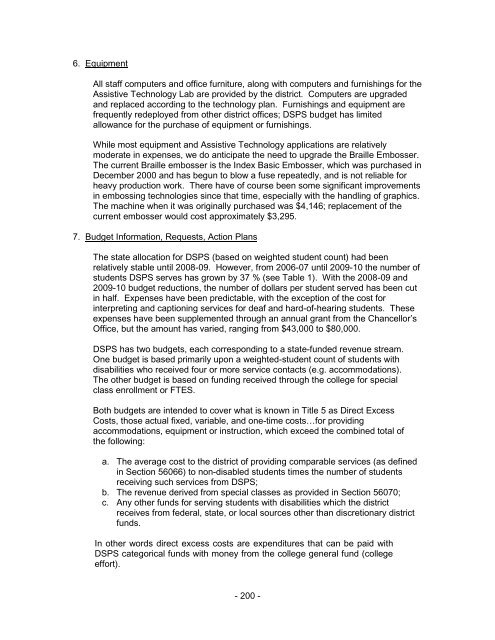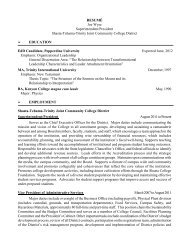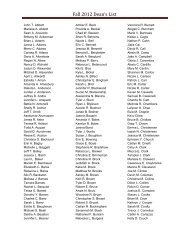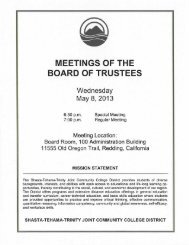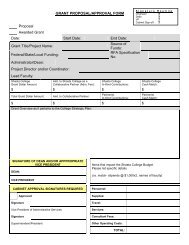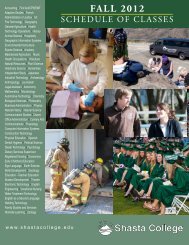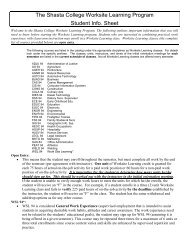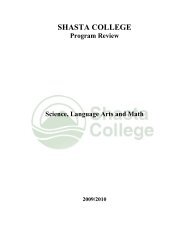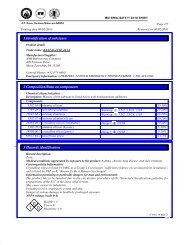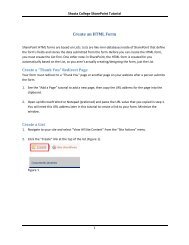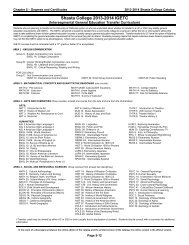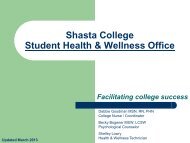- Page 1:
Shasta CollegeStudent ServicesProgr
- Page 9 and 10:
Chair and counselor trainer. Anothe
- Page 11 and 12:
Due to funding considerations, the
- Page 13 and 14:
Lois CushnieFaculty Co-Chair, Matri
- Page 15:
attend, several workshops were offe
- Page 19:
In the area of Matriculation Servic
- Page 27:
In speaking with colleagues at the
- Page 30 and 31:
The following table shows the relea
- Page 32 and 33:
The following table illustrates the
- Page 34 and 35:
Counseling Center employees. The Co
- Page 36 and 37:
TotalNumber ofFaculty*Number ofSubj
- Page 38 and 39:
4. Retention and SuccessWe examined
- Page 40 and 41:
OrientationOne process that was red
- Page 42 and 43:
A note about orientation data: Orie
- Page 44 and 45:
Table 18: Academic Standing by Acad
- Page 46 and 47:
Saw aCounselorDid not see aCounselo
- Page 48 and 49:
NumberAcademic Year07-08 08-09Perce
- Page 50 and 51:
- 48 -Academic Year07-08 08-09Numbe
- Page 52 and 53:
Academic Year07-08 08-09Number Perc
- Page 54 and 55:
II. Quality StaffingWhenever the op
- Page 56 and 57:
SAO: Counseling staff will develop
- Page 58 and 59:
6. Need to continue to improve the
- Page 60 and 61:
3. Continue to develop a comprehens
- Page 62 and 63:
APPENDIX AShasta College - Who Part
- Page 64 and 65:
APPENDIX AShasta College - Who Part
- Page 66 and 67:
APPENDIX AShasta College - Impact o
- Page 68 and 69:
APPENDIX AShasta College - Impact o
- Page 70 and 71:
APPENDIX AShasta College - Orientat
- Page 72 and 73:
APPENDIX AShasta College - Orientat
- Page 74 and 75:
2. Admissions and Records staff wil
- Page 76 and 77:
APPENDIX B - Program PlanAssessment
- Page 78 and 79:
Strengths and Accomplishments:1. An
- Page 80 and 81:
APPENDIX B - Program PlanCareer Cen
- Page 82 and 83:
7. Workshops are held each year for
- Page 84 and 85:
Service Area Outcomes:1. The Counse
- Page 86 and 87:
6. We have had continuing problems
- Page 88 and 89:
11. Represent Shasta College by par
- Page 90 and 91:
4. Due to the increasing regional u
- Page 92 and 93:
Community Engagement1. Enhance the
- Page 94 and 95:
3. To be most effective, there is a
- Page 96 and 97:
2. The Transfer Center will increas
- Page 98 and 99:
APPENDIX CCounseling CenterAction P
- Page 100:
SHASTA COLLEGEStudent ServicesProgr
- Page 103 and 104:
Program SLOs/SAOsService Area Outco
- Page 105 and 106:
Brian Spillane - Dean of StudentsSe
- Page 107 and 108:
2. Contact with Other K-12 SchoolsO
- Page 109 and 110:
Student Success1. Reach of Services
- Page 111 and 112:
There was no previous program revie
- Page 113:
SHASTA COLLEGEStudent ServicesProgr
- Page 116 and 117:
Results of DataRecruitment of inter
- Page 118 and 119:
2. Materials and EquipmentThe progr
- Page 120 and 121:
8. Survey other CCs for Common Prac
- Page 122 and 123:
Income: $4,324/FTES; any other ongo
- Page 124 and 125:
Student Learning OutcomesThe follow
- Page 126 and 127:
Allocate 10% of the International S
- Page 128:
SHASTA COLLEGEStudent ServicesProgr
- Page 131 and 132:
Program Service Area Quality1. Staf
- Page 133 and 134:
College Nurse:Internally: Crisis In
- Page 135 and 136:
Effectiveness surveys for the colle
- Page 137 and 138:
The Student Health and Wellness Ser
- Page 139 and 140:
5. Faculty and Classified StaffingS
- Page 141 and 142:
It would be helpful if the program
- Page 143 and 144:
The primary goal of Student Health
- Page 145 and 146:
Goals, Recommendations, Priorities,
- Page 147 and 148:
APPENDIX CStudent Health and Wellne
- Page 149:
SHASTA COLLEGEStudent ServicesProgr
- Page 152 and 153: Program Mission/PurposeTo provide a
- Page 154 and 155: 7. Internal Relations, Integration
- Page 156 and 157: 2. Use of TechnologyThe Residence H
- Page 158 and 159: 3. ProgressOnce a student becomes a
- Page 160 and 161: 3. The Student Residential Housing
- Page 162 and 163: APPENDIX CStudent Residential Housi
- Page 164: SHASTA COLLEGEStudent ServicesProgr
- Page 167 and 168: Program Service Area Quality1. Staf
- Page 169 and 170: 3. Contact with Community Colleges,
- Page 171 and 172: Student Success1. DataCurrently, st
- Page 173 and 174: Student Learning OutcomesA Student
- Page 175 and 176: APPENDIX CStudent Senate, Clubs, an
- Page 178 and 179: Student Services Program ReviewDisa
- Page 180 and 181: The California Community College Ch
- Page 182 and 183: Assessment: Periodic comparison wil
- Page 184 and 185: Assessment: Pre- and post-evaluatio
- Page 186 and 187: In May 2008, the full-time, tenured
- Page 188 and 189: Three tenured, non-instructional fa
- Page 190 and 191: As mentioned previously, all facult
- Page 192 and 193: into two areas. There is an 800 ft
- Page 194 and 195: semi-annually for dissemination of
- Page 196 and 197: EOPSFinancial AidMISShared space, c
- Page 198 and 199: In summer 2009, the DSPS reception
- Page 200 and 201: 2. Use of TechnologySpecific suppor
- Page 204 and 205: DSPS is the office designated by th
- Page 206 and 207: SemesterComparison of students in D
- Page 208 and 209: Table 19: Enrollment Level and Succ
- Page 210 and 211: 5. Student SatisfactionStandardized
- Page 212 and 213: Goals, Recommendations, Priorities,
- Page 214 and 215: Table 21: Goals from Program Review
- Page 216 and 217: Appendix A - Student Learning Outco
- Page 218 and 219: Appendix A - Student Learning Outco
- Page 220 and 221: Appendix A - Student Learning Outco
- Page 222 and 223: Appendix A - Student Learning Outco
- Page 224 and 225: Appendix A - Student Learning Outco
- Page 226 and 227: Appendix A - Student Learning Outco
- Page 228 and 229: Appendix A - Student Learning Outco
- Page 230 and 231: Appendix A - Student Learning Outco
- Page 232 and 233: APPENDIX CDisabled Students Program
- Page 234: SHASTA COLLEGEStudent ServicesProgr
- Page 237 and 238: EOPSProgramSemesterThe EOPS Program
- Page 239 and 240: Current Staffing LevelsEOPS is gove
- Page 241 and 242: Transfer AdvisingFee WaiversStudent
- Page 243 and 244: Awards ProgramFor the past ten year
- Page 245 and 246: 8. Survey other CCs for Common Prac
- Page 247 and 248: In addition, some CSU counselors ha
- Page 249 and 250: As can be seen, Shasta College is a
- Page 251 and 252: 8. Reach of ServicesAn adjunct EOPS
- Page 253 and 254:
Figure 1: EOPS Course Enrollment by
- Page 255 and 256:
Table: 13 Units Completed by EOPS S
- Page 257 and 258:
Table 15 is mostly incomplete, but
- Page 259 and 260:
EOPS at Shasta College does outreac
- Page 261 and 262:
Appendix A - Student Learning Outco
- Page 263 and 264:
Service Area OutcomeEOPS/CARE wants
- Page 265:
SHASTA COLLEGEStudent ServicesProgr
- Page 268 and 269:
egin college without a high school
- Page 270 and 271:
Staff processed over 6,000 complete
- Page 272 and 273:
$142,000.00 in state scholarships d
- Page 274 and 275:
6. EquipmentThe only issue with equ
- Page 276 and 277:
2. Access3. Progress4. SuccessThe C
- Page 278 and 279:
that may affect their financial aid
- Page 280 and 281:
Challenges3. The ability to offer s
- Page 282 and 283:
APPENDIX AFinancial Aid OfficeStude
- Page 284:
SHASTA COLLEGEStudent ServicesProgr
- Page 287 and 288:
“systematic reform efforts” suc
- Page 289 and 290:
Program Service Area Quality1. Staf
- Page 291 and 292:
serve on the accreditation team as
- Page 293 and 294:
On-going attempts to raise awarenes
- Page 295 and 296:
enefit from additional program part
- Page 297 and 298:
Table 2: Outcome Data for 2009-2010
- Page 299 and 300:
2. (continued) Current 10 th Grader
- Page 301 and 302:
5. Each project year, GEAR UP stude
- Page 303 and 304:
8. (continued) 9 th and 10 th Grade
- Page 305 and 306:
General PlanningThe GEAR UP program
- Page 307 and 308:
APPENDIX CGaining Early Awareness a
- Page 310 and 311:
Student Services Program ReviewTRiO
- Page 312 and 313:
Program SLOs/SAOsService Area Outco
- Page 314 and 315:
US Department of Education, communi
- Page 316 and 317:
Greater collaboration with CSU Chic
- Page 318 and 319:
primary database for tracking progr
- Page 320 and 321:
Table 2: Outcome Data for 2009Objec
- Page 322 and 323:
Table 4: HEOA Amendments and Impact
- Page 324:
SHASTA COLLEGEStudent ServicesProgr
- Page 327 and 328:
change, the Higher Education and Op
- Page 329 and 330:
will lead program design and counse
- Page 331 and 332:
communication between program staff
- Page 333 and 334:
5. Faculty and Classified StaffingT
- Page 335 and 336:
Student Learning OutcomesStudent Le
- Page 337 and 338:
APPENDIX CTRiO Student Support Serv
- Page 340 and 341:
Student Services Program ReviewTRiO
- Page 342 and 343:
2. Upward Bound High school partici
- Page 344 and 345:
) if having a common Director would
- Page 346 and 347:
strong relationships with our partn
- Page 348 and 349:
3. Comparison with Other Institutio
- Page 350 and 351:
Table 2: Outcome Data for 2009Objec
- Page 352 and 353:
Goals, Recommendations, Priorities,


